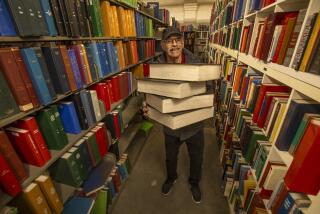If someone had made it, he wanted to take it home
- Share via
DOYLESTOWN, Pa. — Not far from the Main Street charm of this central Bucks County community, amid a group of towering shade trees, sits a jarring sight: a concrete castle, gray but grand, unadorned yet surprisingly majestic in appearance.
Inside is just as strange. A hallway opens to a cavernous central court with dizzying spiral staircases of all sizes, soaring cathedral-like ceilings and tucked-away “secret” rooms. Meticulously numbered objects perch, jut and hang from seemingly every available space in the seven-story structure.
“When you first walk in and look up, that’s what we call the ‘wow’ moment,” said Karen Benson, spokeswoman for the Mercer Museum, the unconventional and scholarly vision of Henry Chapman Mercer.
Made entirely of reinforced concrete -- including bookcases and windowpanes -- the museum was largely a local curiosity after it opened in 1916 but is now visited by some 60,000 people annually and boasts about 50,000 artifacts.
The museum was designated a National Historic Landmark in 1985 along with its concrete companion next door, Fonthill, Mercer’s 44-room mansion and now a museum focusing on his life and work. Both structures, along with the Moravian Pottery and Tile Works that Mercer founded, tell the story of the architect, collector, businessman, historian, writer, archeologist, animal lover and champion of the arts and crafts movement.
“He was a man with a foot in both centuries,” said Cleota Reed, who wrote a 1996 biography of Mercer based on his letters and diaries. “People thought of him as eccentric, but he was really just more forward-thinking.”
Long before modern-day “material culture” studies, Mercer believed that humanity’s progress could be traced by studying its tools. He was distressed to see that many long-used hand tools were being relegated to the junk heap at the dawn of the Industrial Age. So he began to collect and save whatever he could find, for study by future generations.
The museum’s holdings include recognizable objects such as a stagecoach, unusual items like a clover header (used to harvest clover) and eerie things such as a gallows and a “vampire killing kit.”
The concrete construction of the mansion and museum -- where Mercer once set a bonfire on the roof to prove it was fireproof -- was inspired by his arts and crafts-rooted aesthetic and serves as a showcase for his decorative tile work on the walls, ceilings and fireplace mantels. Some historians also have suggested that Mercer developed a pathological fear of fire after his uncle lost a valuable medieval armor collection in the Great Fire of Boston in 1872.
“I don’t think that was necessarily the case,” museum curator Cory Amsler said. “He spent so much time collecting and he wanted to safeguard it, and [concrete] was a material that had artistic properties as well.”
Mercer was born in Doylestown in 1856. He came from an esteemed family -- both grandfathers were politicians, and his mother was a socialite. His father, who went to the U.S. Naval Academy at Annapolis, resigned his commission and settled his family in Bucks County. Mercer largely was supported by a wealthy aunt, who left him a large inheritance. A Harvard University graduate, he spent much of his youth traveling the world.
Mercer returned to the United States in 1891 after winning a position at the new Museum of Science and Art at the University of Pennsylvania, in which he went on archeological digs and collected artifacts. He left six years later, around the time he became interested in pottery after searching out examples for his collection.
In 1899 he built the Moravian Pottery and Tile Works to manufacture decorative arts and crafts tile. The company was profitable and renowned almost from the start, and it still manufactures tiles just as it did more than a century ago.
By most accounts, Mercer, who never married, became cantankerous in his later years, bemoaning “modern” developments from hot dogs and cocktails to women’s bobbed hair and daylight savings time.
“I saw him leave that castle every day, on a bicycle, with two dogs, and pass within 10 feet of me,” the late author James Michener once recalled. Michener’s modest childhood home was a mile from the grand Mercer estate. “In all those years, he never once looked at me or spoke to me or recognized me in any way. I was, in the English sense, one of the peasants on his domain.”
When Mercer died in 1930, he had amassed nearly 25,000 artifacts for his collection.
“At the end of his life, he had somebody in China who was studying preindustrial tools there so he could compare them with Western tools,” Reed said. “He had more ideas than he had time. He was doing research until the end.”
More to Read
The biggest entertainment stories
Get our big stories about Hollywood, film, television, music, arts, culture and more right in your inbox as soon as they publish.
You may occasionally receive promotional content from the Los Angeles Times.










